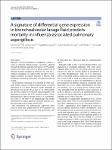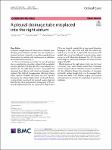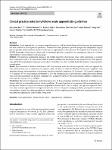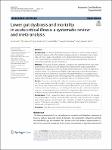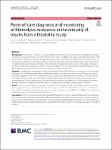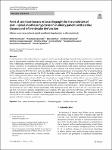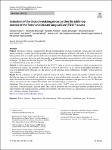Search
Author
- Daqing, Ma (3)
- Alexis, Ferré (2)
- Anna, Lybeck (2)
- Ashish K., Khanna (2)
- next >
Subject
- intensive care unit (8)
- acute respiratory dist... (5)
- chronic obstructive pu... (5)
- ICU (5)
- next >
Date issued
Has File(s)
Search Results
Influenza-associated pulmonary aspergillosis (IAPA) is a severe co-infection with the fungus Aspergillus, affecting critically ill influenza patients. Mortality of IAPA patients reaches 45%, more than twice as much as observed in influenza patients admitted to intensive care unit (ICU) without aspergillosis [1]. Importantly, the effect of antifungal treatment on patient outcome is limited, while prognostic biomarkers tailored for this patient group are lacking. |
Lung ultrasonography (LUS) has become an essential component of the evaluation and clinical management of patients admitted to the intensive care unit (ICU). The interpretation of LUS artifact (A- and B-patterns), analysis of the pleura, and the visualization of real images (C pattern) have demonstrated usefulness for the differential diagnosis of acute respiratory failure (ARF) [1]. However, current methods are non-quantitative and have important drawbacks deriving from visually guided assessment of LUS data [2]. Interestingly, recent in vitro and in vivo studies suggest that LUS data carry valuable information that correlates with lung density [2]. |
A 70-year-old female presented to our department due to requiring for extracting a pleural tube penetrated into the right heart 22 days ago. She was previously hospitalized for the right femur fracture. The patient had rheumatic heart disease with mitral and tricuspid valves replaced. She suffered deoxygenation following internal femur fixation. |
Acute appendicitis is a common surgical emergency, and the standard approach to diagnosis and management has been codified in several practice guidelines. Adherence to these guidelines provides insight into independent surgical practice patterns and institutional resource constraints as impediments to best practice. We explored data from the recent ESTES SnapAppy observational cohort study to determine guideline compliance in contemporary practice to identify opportunities to close evidence-to-practice gaps. |
The human gastrointestinal tract harbours a complex multi-kingdom community known as the microbiome. Dysbiosis refers to its disruption and is reportedly extreme in acute critical illness yet its clinical implications are unresolved. The review systematically evaluates the association between gut dysbiosis and clinical outcomes of patients early in critical illness. |
ibrinolysisis is essential for vascular blood flow maintenance and is triggered by endothelial and platelet release of tissue plasminogen activator (t-PA). In certain critical conditions, e.g. sepsis, acute respiratory failure (ARF) and trauma, the fibrinolytic response is reduced and may lead to widespread thrombosis and multi-organ failure. The mechanisms underpinning fibrinolysis resistance include reduced t-PA expression and/or release, reduced t-PA and/or plasmin effect due to elevated inhibitor levels, increased consumption and/or clearance. This study in critically ill patients with fibrinolysis resistance aimed to evaluate the ability of t-PA and plasminogen supplementation to restore fibrinolysis with assessment using point-of-care ClotPro viscoelastic testing (VET). |
Retrospective cohorts have suggested that levosimendan may facilitate the weaning of veno-arterial extracorporeal membrane oxygenation (VA-ECMO). We therefore studied this clinical question by emulating a randomized trial with observational data. |
In elderly patients with cardiac diseases, changes in cardiovascular physiology diminish cardiovascular reserve and predispose to hemodynamic instability after spinal anesthesia; hence, such patients could be at risk of postoperative complications. Additionally, transthoracic echocardiography (TTE) is used in clinical practice to evaluate cardiovascular hemodynamics. Therefore, we hypothesized that echocardiographic measurements could display significant diagnostic power in the prediction of post - spinal anesthesia hypotension in elderly patients with cardiac diseases and reduced left ventricular ejection fraction (LV-EF). Therefore, sixty-one elderly orthopedic-trauma patients were recruited. Prior to spinal anesthesia a TTE examination was performed. |
During general anesthesia, the surgical pleth index (SPI) monitors nociception. The evidence of SPI in the elderly remains scarce. We aimed to investigate whether there is a difference in perioperative outcomes following intraoperative opioid administration according to the surgical pleth index (SPI) value versus hemodynamic parameters (heart rate or blood pressure) in elderly patients. |
The threat of terror is omnipresent in Europe and the number of attacks worldwide is increasing. The target of attacks in Europe is usually the civilian population. Incalculable dangerous situations at the scene of the event and severe injury patterns such as complex gunshot and explosion injuries with a high number of highly life-threatening people present rescue forces, emergency physicians and subsequently hospitals with medical, organizational as well as tactical and strategic challenges. The Terror and Disaster Surgical Care (TDSC®) course trains clinical decision-makers to meet these challenges of a TerrorMASCAL in the first 24–48 h. |

